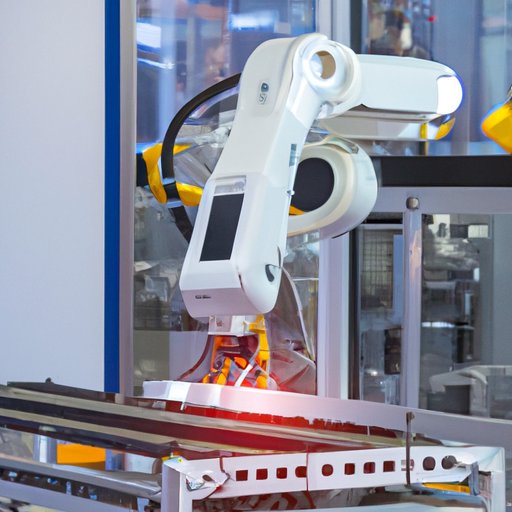Introduction
Industrial robots are automated machines that are used to perform a variety of tasks. They are programmed to carry out specific jobs with precision and accuracy, allowing for more efficient production lines. This article will explore the uses of industrial robots, their benefits, types and cost-effectiveness.
Uses of Industrial Robots
Industrial robots are widely used in manufacturing to carry out a variety of tasks such as welding, painting, cutting, assembly and packaging. According to a study by the International Federation of Robotics (IFR), industrial robots are being used in various industries including automotive, electronics, metal and machinery, plastics and rubber, food and beverages, chemical and pharmaceuticals, logistic and warehousing.
The use of industrial robots has many benefits. For example, they can increase productivity by reducing the need for manual labor, allowing for faster production rates. Additionally, industrial robots can operate 24 hours a day, 7 days a week, meaning that manufacturers can increase their output without having to worry about fatigue or breaks. Furthermore, industrial robots are able to work consistently with high levels of accuracy and repeatability, which reduces the risk of human error.
Industrial robots have revolutionized production lines by enabling manufacturers to produce goods faster and cheaper. By automating processes, manufacturers can reduce costs associated with labor, energy and time. For example, a study by the Massachusetts Institute of Technology found that using industrial robots can reduce labor costs by up to 50%. Additionally, industrial robots can reduce the amount of energy needed to power a production line, resulting in lower electricity bills and a reduced environmental impact.
Industrial robots also offer advantages in terms of safety. By reducing the need for human workers in hazardous environments, industrial robots can help to reduce the risk of accidents and injuries. Additionally, industrial robots are equipped with safety features such as sensors, cameras and emergency stop buttons, which can help to prevent accidents and mitigate any potential damage.
Types of Industrial Robots
There are several different types of industrial robots, each designed to carry out specific tasks. For example, articulated robots are used for welding, painting and assembling components, while Cartesian robots are used for pick-and-place tasks. Additionally, cylindrical robots are used for handling materials, and SCARA robots are used for packaging and palletizing. Each type of industrial robot is equipped with safety features such as sensors and cameras, which can help to prevent accidents and ensure the safety of workers.
Cost-Effectiveness of Industrial Robots
The cost of industrial robots depends on the type of robot, its capabilities and the complexity of the task it is required to perform. Generally speaking, industrial robots are more expensive than traditional manual labor, but they can be cost-effective in the long run. According to a study by the National Institute of Standards and Technology, the total cost of ownership for an industrial robot can be up to 40% less than for manual labor over the course of its lifetime.
Furthermore, the cost savings associated with industrial robots can be even greater if they are used in conjunction with other automation technologies such as vision systems, conveyors and machine learning algorithms. By combining these technologies, manufacturers can reduce labor costs, increase production rates and improve product quality.
Conclusion
In conclusion, industrial robots are automated machines that are used to perform a variety of tasks. They offer many benefits such as increased productivity, improved safety and cost savings. There are several different types of industrial robots, each designed to carry out specific tasks. Additionally, industrial robots can be cost-effective in the long run if they are used in conjunction with other automation technologies. Overall, industrial robots are a valuable tool for manufacturers looking to improve their production lines.
(Note: Is this article not meeting your expectations? Do you have knowledge or insights to share? Unlock new opportunities and expand your reach by joining our authors team. Click Registration to join us and share your expertise with our readers.)
